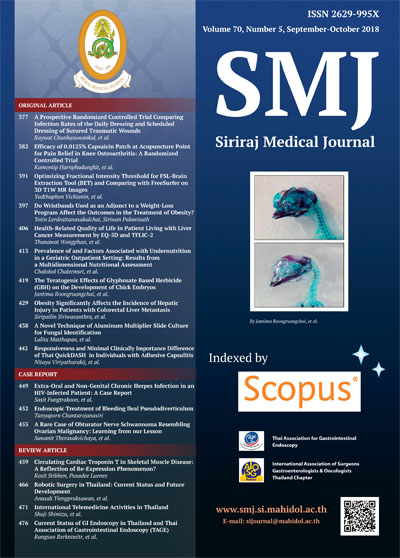Health-Related Quality of Life as Measured by EQ-5D and TFLIC-2 in Liver Cancer Patients
Keywords:
Liver cancer; quality of life; EQ-5D; T-FLIC 2Abstract
Objective: To assess the relation and estimation function between utility weight (UW) from EQ-5D and T-FLIC
2 score (TFS). To compare quality of life (QOL) between global burden of disease (GBD) and TNM staging.
Methods: All liver cancer patients which presented in selected hospitals in 2009, were asked their QOL by EQ-5D
and T-FLIC 2 questionnaires. The relation between UW and TFS was analyzed by using Pearson’s correlation and
the linear regression. The means of UW and TFS in specific conditions were compared with independent t-test
and ANOVA.
Results: There were 53 cases. The majority (73.6 %) were men, mean age was 57.2 years, lived in suburban area
(67.9%), worked in agriculture (47.2%) and graduated secondary level or lower (83.0%). These 73.6% of all samples
had household monthly income not greater than 5,000 THB and used universal coverage scheme (64.2%). Seventeen
cases had not been identified TNM staging because of the condition of patients. However, those cases fulfilled to be
diagnosed terminal stage. The multiple comparisons between means of UW and TFS showed no statistical significance
e.g. pre-terminal and terminal (0.5 vs 0.4, p=0.3 and 38.8 vs 34.0, p=0.2 respectively), TNM-stage 4 vs TNM-stage
1-3 (0.3 vs 0.5, p=0.3 and 38.9, 30.5, p=0.1), and supportive only vs. other treatment (0.5 vs 0.5, p=0.9, and 32.8 vs
36.2, p=0.5). The correlation between UW and TFS was significantly related (p<0.001) with linear pattern (p<0.001).
The equation for estimating UW from TFS and specific Q1-Q22 questions was formulated.
Conclusion: This study revealed the significant correlation between UW and TFS with linear pattern. A major
advantage of using regression analysis was predicting UW from TFS for economic evaluation in Thai liver cancer
patients. The treatment might not alter QOL significantly. Given cancer stage and treatment choice and their QOL
in this study, our findings should not be over-interpreted.
Published
How to Cite
Issue
Section
License
Authors who publish with this journal agree to the following conditions:
Copyright Transfer
In submitting a manuscript, the authors acknowledge that the work will become the copyrighted property of Siriraj Medical Journal upon publication.
License
Articles are licensed under a Creative Commons Attribution-NonCommercial-NoDerivatives 4.0 International License (CC BY-NC-ND 4.0). This license allows for the sharing of the work for non-commercial purposes with proper attribution to the authors and the journal. However, it does not permit modifications or the creation of derivative works.
Sharing and Access
Authors are encouraged to share their article on their personal or institutional websites and through other non-commercial platforms. Doing so can increase readership and citations.











